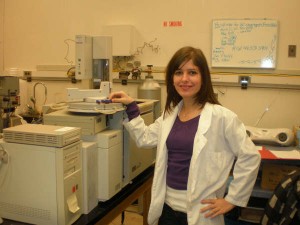Marina Saccon
 Compound Specific Studies of Particle Phase Photo-Oxidation Products of Alkylbenzenes in the Atmosphere. Atmospheric particulate matter (PM) adversely affects health and climate, and the development of effective strategies to mitigate these adverse impacts require understanding the origin and transformations of PM suspended in the atmosphere. One of the still poorly understood sources of PM is the formation of secondary organic PM from the photo-oxidation of atmospheric VOCs. Toluene and other alkylbenzenes are emitted by vehicle exhausts and can undergo photo-oxidation in the atmosphere to produce secondary particulate organic matter (POM). One group of compounds identified as products of the photo-oxidation of alkylbenzenes are nitrophenols. A method has been developed to quantify concentrations of methyl nitrophenols, a product of the photo-oxidation of toluene in the atmosphere. In this study the method is applied to atmospheric studies and tested for the application to other secondary POM.
Compound Specific Studies of Particle Phase Photo-Oxidation Products of Alkylbenzenes in the Atmosphere. Atmospheric particulate matter (PM) adversely affects health and climate, and the development of effective strategies to mitigate these adverse impacts require understanding the origin and transformations of PM suspended in the atmosphere. One of the still poorly understood sources of PM is the formation of secondary organic PM from the photo-oxidation of atmospheric VOCs. Toluene and other alkylbenzenes are emitted by vehicle exhausts and can undergo photo-oxidation in the atmosphere to produce secondary particulate organic matter (POM). One group of compounds identified as products of the photo-oxidation of alkylbenzenes are nitrophenols. A method has been developed to quantify concentrations of methyl nitrophenols, a product of the photo-oxidation of toluene in the atmosphere. In this study the method is applied to atmospheric studies and tested for the application to other secondary POM.
Christine Facca
 Concentration measurements and gas-particle partitioning of atmospheric nitrophenols: Nitrophenols are toxic, semi-volatile compounds, which are formed in the atmosphere by OH-radical initiated photo-oxidation of aromatic hydrocarbons, such as toluene. Due to their semi-volatile nature, nitrophenols can exist in the atmosphere in both the gas and particle phase, which makes understanding their partitioning important for understanding of the formation and processing of secondary organic matter. My research involves the use of an IOGAPS (Integrated Organic Gas and Particle Sampler) to measure gas and particle phase nitrophenols separately. The IOGAPS system employs an annular denuder which collects gas phase semi-volatile compounds and 47 mm quartz fibre filters for the collection of particulate matter. The first part of my project encompassed taking the IOGAPS system, used primarily on PAH studies, and adapting it for analysis of nitrophenol compounds. Once this method was proven to be valid, focus shifted to performing year-round ambient measurements using the IOGAPS system in parallel to typical high-volume air sampling. Future work involves continuing sampling and using the concentration measurements of these atmospheric nitrophenols in the gas and paticle phases to better understand their partitioning and therefore their atmospheric fates.
Concentration measurements and gas-particle partitioning of atmospheric nitrophenols: Nitrophenols are toxic, semi-volatile compounds, which are formed in the atmosphere by OH-radical initiated photo-oxidation of aromatic hydrocarbons, such as toluene. Due to their semi-volatile nature, nitrophenols can exist in the atmosphere in both the gas and particle phase, which makes understanding their partitioning important for understanding of the formation and processing of secondary organic matter. My research involves the use of an IOGAPS (Integrated Organic Gas and Particle Sampler) to measure gas and particle phase nitrophenols separately. The IOGAPS system employs an annular denuder which collects gas phase semi-volatile compounds and 47 mm quartz fibre filters for the collection of particulate matter. The first part of my project encompassed taking the IOGAPS system, used primarily on PAH studies, and adapting it for analysis of nitrophenol compounds. Once this method was proven to be valid, focus shifted to performing year-round ambient measurements using the IOGAPS system in parallel to typical high-volume air sampling. Future work involves continuing sampling and using the concentration measurements of these atmospheric nitrophenols in the gas and paticle phases to better understand their partitioning and therefore their atmospheric fates.
